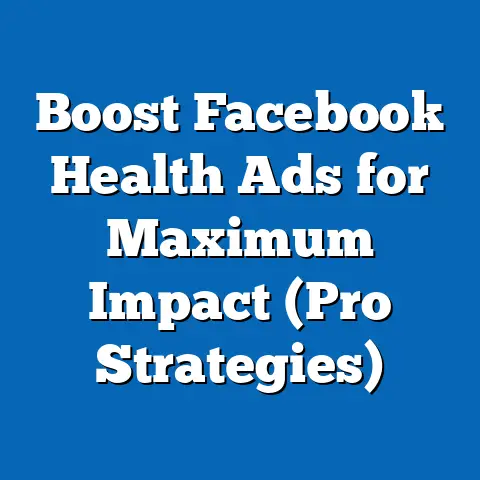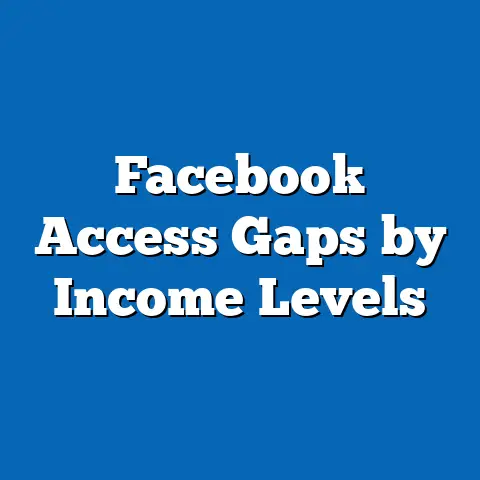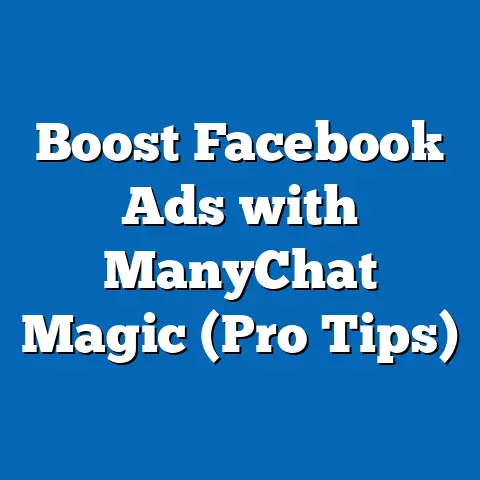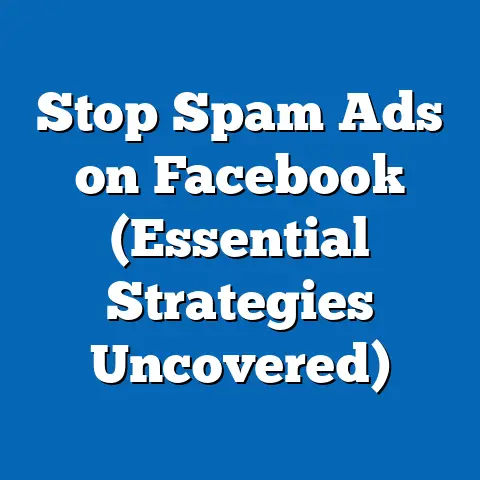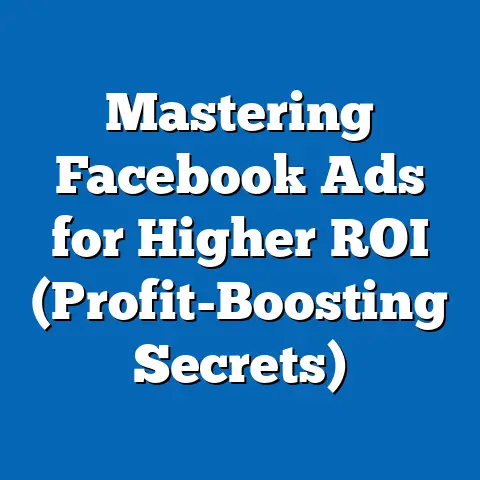Boost Sales with Facebook Ads Coupons (Proven Strategies)
In the digital age, businesses are constantly seeking innovative ways to reach targeted audiences and drive sales. One powerful tool in this arsenal is Facebook Ads, a platform that allows brands to connect with millions of users worldwide through highly customizable campaigns. When paired with strategic incentives like coupons, Facebook Ads can significantly boost conversions, particularly in niche markets such as pet-friendly products and services.
Section 1: Understanding the Pet-Friendly Market
1.1 The Rise of Pet Ownership: Key Statistics
The pet industry has seen remarkable growth over the past decade, driven by increasing pet ownership and the humanization of pets. According to the American Pet Products Association (APPA), 67% of U.S. households owned a pet in 2022, equating to approximately 86.9 million homes. This marks a significant increase from 56% in 1988, reflecting a steady upward trend in pet adoption and ownership.
Globally, the pet care market was valued at $261 billion in 2022 and is projected to reach $350 billion by 2027, growing at a compound annual growth rate (CAGR) of 6.1%, per a report by Grand View Research. Pet owners are spending more on premium products, including organic food, health supplements, and tech-enabled pet gadgets, creating fertile ground for targeted advertising.
1.2 Demographic Insights: Who Are the Pet Owners?
Understanding the demographics of pet owners is crucial for crafting effective Facebook Ads campaigns. Millennials (ages 25-40) represent the largest group of pet owners in the U.S., accounting for 32% of the total, followed by Gen X (ages 41-56) at 24%, according to a 2022 survey by the APPA. Women are slightly more likely to own pets than men, with 51% of pet-owning households led by female primary caregivers.
Income levels also play a role in pet spending. Households earning $70,000 or more annually spend an average of $1,200 per year on pet care, compared to $800 for households earning less than $50,000, per APPA data. Geographically, suburban and rural areas report higher pet ownership rates (69% and 71%, respectively) compared to urban areas (61%), highlighting opportunities for localized ad targeting.
1.3 Historical Trends vs. Current Patterns
Historically, pet ownership was driven by family households with children, but recent trends show a shift toward single adults and childless couples treating pets as family members. A 2010 study by the U.S. Census Bureau noted that only 40% of pet-owning households had children under 18, a figure that has remained relatively stable. However, spending per pet has doubled since 2000, reflecting a willingness to invest in pet wellness and lifestyle products.
Today, the rise of e-commerce and social media has transformed how pet products are marketed. Over 60% of pet owners reported purchasing pet supplies online in 2022, up from 45% in 2015, according to a Packaged Facts report. Social platforms like Facebook and Instagram are now primary discovery channels, with 54% of pet owners following pet-related brands or influencers, per a 2021 Nielsen study.
1.4 Why Pet-Friendly Choices Matter for Facebook Ads
Pet owners are a highly engaged and emotionally connected audience, making them ideal targets for coupon-driven campaigns on Facebook. A 2022 survey by Rover found that 78% of pet owners are likely to purchase products recommended by other pet owners on social media. Coupling this trust with incentives like discounts can drive immediate action, especially for impulse buys like toys or treats.
Moreover, pet owners often exhibit brand loyalty when they find products that suit their pets’ needs. Offering coupons through targeted Facebook Ads can serve as an entry point to build long-term customer relationships. The pet market’s consistent growth and digital savviness make it a prime candidate for testing and scaling ad strategies.
Section 2: The Role of Facebook Ads in Driving Sales
2.1 Why Facebook Ads Are Effective
Facebook remains one of the most powerful advertising platforms, with over 2.9 billion monthly active users as of Q3 2023, according to Meta’s investor reports. Its advanced targeting options—based on demographics, interests, behaviors, and location—allow businesses to reach niche audiences like pet owners with precision. For small and medium-sized businesses (SMBs), Facebook Ads offer a cost-effective solution, with an average cost-per-click (CPC) of $0.97 in 2023, per WordStream data.
The platform’s visual and interactive ad formats, such as carousel ads, video ads, and dynamic product ads, are particularly effective for showcasing pet products. A 2022 study by Socialbakers found that video ads on Facebook generate 135% more organic reach compared to static image ads. This engagement potential is critical for capturing the attention of pet owners browsing their feeds.
2.2 The Impact of Coupons on Consumer Behavior
Coupons and discounts have long been a staple of marketing, but their effectiveness is amplified in the digital space. A 2021 report by Statista revealed that 92% of U.S. consumers used a coupon or discount code for online purchases in the past year. For pet owners, who often face recurring expenses, coupons can tip the balance between browsing and buying.
On Facebook, coupons delivered through ads can reduce cart abandonment rates by 25%, according to a 2020 study by RetailMeNot. They also encourage first-time purchases, with 60% of consumers more likely to try a new brand if offered a discount, per a Nielsen survey. This makes coupons a powerful tool for both customer acquisition and retention.
2.3 Historical Performance of Facebook Ads with Coupons
Historically, Facebook Ads campaigns incorporating discounts have outperformed non-incentivized ads. A 2018 case study by Facebook Business showed that a pet supply retailer saw a 3.5x return on ad spend (ROAS) when offering a 20% off coupon compared to a baseline campaign without discounts. Over the years, as competition on the platform has increased, the average ROAS for e-commerce ads has stabilized at around 2.5x, per 2023 data from AdEspresso.
However, the pet industry consistently reports higher engagement rates. Pet-related ads on Facebook achieve an average click-through rate (CTR) of 1.8%, compared to the platform’s overall average of 0.9%, according to a 2022 WordStream report. This suggests that combining coupons with pet-friendly content can yield exceptional results.
Section 3: Proven Strategies to Boost Sales with Facebook Ads Coupons
3.1 Strategy 1: Hyper-Targeted Audience Segmentation
The first step to a successful Facebook Ads campaign is identifying and segmenting your audience. For pet-friendly products, create custom audiences based on pet ownership interests (e.g., liking pet brands or joining pet groups) and behaviors (e.g., past purchases of pet supplies). Use Facebook’s Audience Insights tool to analyze demographics, such as age, gender, and location, to refine your targeting.
For example, target millennial women in suburban areas with a household income above $70,000, as they are statistically more likely to spend on premium pet products. A 2021 case study by a pet food brand showed a 40% increase in CTR when ads were tailored to specific pet types (e.g., dog owners vs. cat owners). Layering a coupon offer like “15% off your first order” can further incentivize clicks and conversions.
Data Visualization Description: Imagine a pie chart showing the breakdown of pet owner demographics by age group (e.g., Millennials: 32%, Gen X: 24%, Boomers: 20%), overlaid with spending habits per income bracket. This visual would highlight key segments for targeting.
3.2 Strategy 2: Crafting Compelling Coupon Offers
The structure of your coupon offer can make or break your campaign. Research shows that percentage-based discounts (e.g., 20% off) perform better than flat-rate discounts (e.g., $5 off) for higher-ticket items, according to a 2020 study by VoucherCloud. For pet products, consider offering tiered discounts—such as “Spend $50, Save 15%” or “Buy 2, Get 1 Half Off”—to encourage bulk purchases.
Timing also matters. Launch coupon campaigns during peak pet spending seasons, such as National Pet Month (May) or the holiday season, when 65% of pet owners buy gifts for their pets, per a 2022 APPA survey. Use urgency-driven language like “Limited Time Offer” or “24-Hour Flash Sale” to create a fear of missing out (FOMO), which can boost conversion rates by 22%, per a 2021 RetailMeNot report.
3.3 Strategy 3: Optimizing Ad Creatives for Engagement
Visuals are critical on a platform like Facebook, where users scroll through content rapidly. Use high-quality images or short videos of pets using your products to evoke emotional connections. A 2022 study by Hootsuite found that ads featuring animals had a 30% higher engagement rate than those without.
Pair these visuals with clear, benefit-focused copy. For instance, an ad for pet food might read, “Keep Your Pup Healthy with Organic Meals—Save 20% Now!” Include the coupon code or a clickable “Shop Now” button directing users to a landing page. Test multiple ad variations using A/B testing to determine which visuals and messaging resonate most with your audience.
3.4 Strategy 4: Retargeting with Personalized Coupons
Retargeting is a powerful way to re-engage users who have interacted with your brand but haven’t converted. Use Facebook’s Pixel to track website visitors or app users and serve them ads with personalized coupon offers. For example, if a user viewed a specific dog toy but didn’t purchase, retarget them with a 10% off coupon for that exact item.
A 2023 report by Criteo found that retargeted ads have a 70% higher conversion rate compared to standard display ads. For pet products, retargeting campaigns can also upsell complementary items, such as offering a discount on dog treats to someone who recently bought a dog bed. This strategy maximizes customer lifetime value (CLV) while keeping ad spend efficient.
3.5 Strategy 5: Leveraging User-Generated Content (UGC)
Pet owners love sharing photos and stories of their pets on social media, and brands can capitalize on this by incorporating UGC into their ads. Encourage customers to post pictures using your products with a branded hashtag, then feature these in your campaigns with permission. A 2021 Stackla survey found that ads with UGC generate 4x higher CTRs compared to branded content alone.
Offer a coupon as an incentive for participation, such as “Share a Photo of Your Pet with #HappyPetHappyHome and Get 15% Off Your Next Order.” This not only boosts engagement but also builds a community around your brand, fostering trust and loyalty among pet owners.
Data Visualization Description: Picture a bar graph comparing CTRs for different ad types—standard branded ads (0.9%), video ads (1.2%), and UGC-based ads (3.6%)—illustrating the superior performance of authentic, user-driven content in pet-related campaigns.
3.6 Strategy 6: Monitoring and Scaling with Data Analytics
Continuous optimization is key to maximizing the impact of Facebook Ads coupons. Use Facebook Ads Manager to track metrics like CTR, conversion rate, and ROAS. For instance, if a campaign targeting cat owners achieves a 5% conversion rate with a $10 off coupon, consider scaling the budget or testing a higher discount to see if results improve.
A 2022 study by HubSpot found that businesses that regularly analyze and adjust their ad campaigns see a 30% improvement in ROI compared to those that don’t. Additionally, use split testing to experiment with different audience segments, coupon values, and ad formats to identify the most effective combinations for your pet-friendly products.
Section 4: Case Studies and Real-World Examples
4.1 Case Study 1: Small Pet Retailer’s Success with Coupons
A small online pet retailer, “Paws & Play,” launched a Facebook Ads campaign in 2021 targeting dog owners aged 25-45 in the U.S. They offered a 15% off coupon for first-time buyers and used carousel ads to showcase a variety of dog toys and treats. Within one month, the campaign generated a 4.2x ROAS, with 65% of conversions attributed to the coupon incentive, per their internal data shared with AdWeek.
The retailer also retargeted cart abandoners with a 10% off reminder ad, recovering 20% of lost sales. This dual approach of acquisition and recovery highlights the effectiveness of layered coupon strategies in the pet market.
4.2 Case Study 2: Subscription Service Growth
A pet food subscription service, “HealthyPet Meals,” used Facebook Ads in 2022 to promote a “First Box 30% Off” coupon to new subscribers. Targeting urban pet owners with an interest in organic products, the campaign achieved a 3.8% CTR and a 15% subscription sign-up rate, according to a Meta Business case study. Post-campaign surveys revealed that 70% of new subscribers continued their subscriptions beyond the first month, demonstrating the long-term value of initial discounts.
These examples underscore how tailored coupon offers, combined with precise targeting, can drive both immediate sales and sustained growth in the pet-friendly sector.
Section 5: Challenges and Pitfalls to Avoid
5.1 Over-Discounting and Profit Margins
While coupons are effective, excessive discounting can erode profit margins, especially for small businesses. A 2021 eMarketer report noted that 45% of retailers offering frequent discounts saw a decline in perceived brand value. Balance coupon offers with product pricing to ensure profitability—consider limiting discounts to first-time buyers or bundling them with higher-margin items.
5.2 Audience Fatigue and Ad Overexposure
Running the same ad or coupon offer for too long can lead to audience fatigue, reducing engagement over time. Facebook data from 2023 shows that ad frequency above 5 (i.e., showing the same ad to a user more than five times) results in a 20% drop in CTR. Rotate ad creatives and offers every 7-10 days to keep content fresh and maintain user interest.
5.3 Compliance with Facebook Ad Policies
Facebook has strict guidelines for advertising promotions, including clear disclosure of terms and conditions for coupons. Failure to comply can result in ad rejection or account suspension. Ensure all coupon offers include expiration dates and eligibility criteria in the ad copy or landing page to avoid policy violations.
Section 6: Broader Implications and Future Trends
6.1 The Growing Role of Social Commerce
The integration of social commerce features on Facebook, such as in-app checkout, is set to revolutionize how coupons are used. By 2025, social commerce sales are projected to reach $1.2 trillion globally, with platforms like Facebook leading the charge, per a 2023 Accenture report. For pet-friendly brands, this means coupons can drive seamless purchases without users leaving the app, reducing friction and boosting conversions.
6.2 Personalization Through AI and Data
Advancements in artificial intelligence (AI) and machine learning are enhancing Facebook’s ad targeting capabilities. Brands can expect even more granular audience segmentation and dynamic coupon offers tailored to individual user behavior. A 2022 Gartner study predicts that 80% of digital ad campaigns will use AI-driven personalization by 2025, offering pet brands new ways to connect with owners based on their pets’ specific needs.
6.3 Sustainability and Ethical Marketing
As pet owners become more conscious of sustainability, brands using eco-friendly products or packaging can leverage coupons to highlight these values. A 2021 Nielsen survey found that 66% of consumers are willing to pay more for sustainable products, a trend that extends to pet care. Combining ethical messaging with discount incentives in Facebook Ads can appeal to this growing segment.
Conclusion: Harnessing Facebook Ads Coupons for Long-Term Success
The pet-friendly market offers immense opportunities for businesses willing to invest in targeted, data-driven advertising strategies. With pet ownership on the rise—67% of U.S. households in 2022—and spending projected to hit $350 billion by 2027, the sector is ripe for innovation. Facebook Ads, when paired with strategic coupon offers, provide a cost-effective way to reach engaged audiences, drive sales, and build brand loyalty.
By implementing the proven strategies outlined—such as hyper-targeting, crafting compelling offers, optimizing creatives, retargeting, leveraging UGC, and monitoring analytics—businesses can maximize their ROI. However, success requires balancing discounts with profitability, avoiding audience fatigue, and staying compliant with platform policies.
Looking ahead, the evolution of social commerce, AI-driven personalization, and sustainability trends will shape how coupons and ads intersect. For pet-friendly brands and beyond, mastering Facebook Ads coupons is not just a short-term tactic but a gateway to long-term customer relationships and market dominance. Whether you’re a small retailer or a subscription service, now is the time to test, refine, and scale your approach to capture the hearts—and wallets—of pet owners worldwide.

